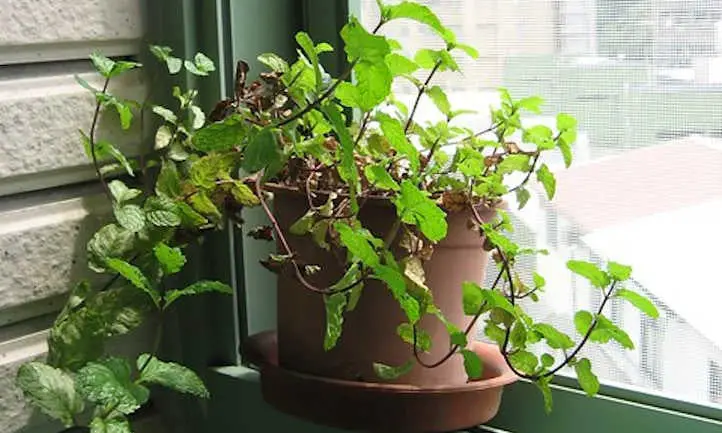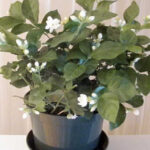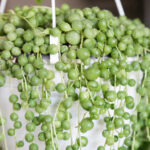All herbs in the Mentha genus have a culinary use and a cultural context from which they come. Whether we’re talking about spearmint, peppermint, or any of the hybrid varieties like chocolate mint or apple mint, you’ll have fresh mint year-round. But say you’re a person who lives in a home without a garden or say you experience mobility issues and gardening is difficult. There is a solution. Growing mint indoors is one way to try gardening in a more accessible way.
Mint (Mentha in taxonomical terms) herb gardens are lush, full of pleasant aroma, and prolific. Some who grow outdoor mint remove it soon after because it takes over! You can grow mint plants indoors and harvest them from your herb garden throughout the year. Mint leaves can be used for delicious teas, meat marinades, or even in homemade cosmetics. Mint can tolerate many extreme conditions and will continue to produce leaves even when stressed.
If you’re new to indoor growing, fear not! Mint is one herb that won’t disappoint. Whether you want to grow mint in an herb garden on your balcony or in a more complicated setup like a hydroponic system, you’ll find these plants to be resilient, pleasant, and fast-growing. With the right growing conditions, you’ll have mint year-round.
One benefit for those who grow mint indoors is they circumvent the risk of planting a somewhat invasive herb in their garden. I’ve grown peppermint in containers outside, and it somehow managed to make its way into a nearby bed. It would have taken over if I hadn’t taken a lot of time to harvest it well. So planting mint indoors is a way to avoid damaging the hard work you’ve done in the earth. It’s an ecological gardening practice!
Ways Of Growing Mint Indoors
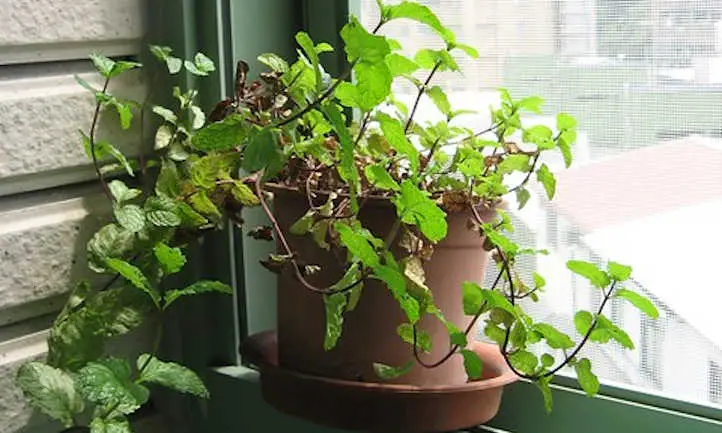
Grow mint indoors in a window sill or an enclosed balcony with a good amount of direct sunlight. If you don’t have any blockages from nearby trees or buildings your mint plant will thrive. However, if the sunlight is blocked you might find growing mint this way more difficult.
If your windows don’t face the proper direction or can’t access enough sunlight, grow lights can help your mint flourish. Move your container to an area where a fluorescent grow light can plug in nearby. Fluorescent lights need to be on for at least 12 hours to grow mint indoors. Many grow lights come with a timer, but some may require manual operation. Find one that is best suited to your needs and the needs of your mint plant.
Grow tents are another option for those who want to grow mint indoors. They may even be the best option for indoor growing because of their capabilities. With a grow tent you can control not only the heat and light surrounding your mint plants, but you can also control the humidity. This is a huge plus since mint enjoys high humidity. Grow tents are good for those who have the space to host them. Smaller grow tents start at dimensions of 2 feet by 2 feet by 4 feet.
Mint is also suited to grow indoors in a hydroponic system. Previously, it was thought that herbs grown in hydroponic systems didn’t have as much flavor as soil-grown herbs. However, there have been advances in hydroponic technology that provide herbs with the proper nutrients for rich flavor. So, this is an option for people who have at least a few feet of counter space to work with.
There are lots of options, including aquaponic systems that are about the size of a small aquarium. However, mint tends to sap nutrients from the soil and water, so care will need to be taken in that regard. Whether you choose to grow in a container or a system, mint plants will do well even when they are ignored for a bit.
Caring For Indoor Mint
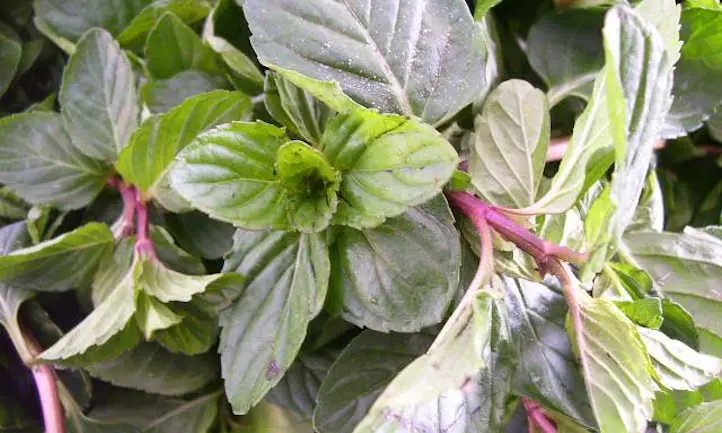
So what is required to grow mint indoors? Since mint is one herb that isn’t finicky, just a few simple things will help you get from point A to point B.
Lighting & Temperature
A mint plant needs at least 6 hours of direct sunlight per day. As mentioned above, fluorescent lights should be on your mint plant for at least 12 hours per day. In the northern hemisphere, a south-facing window will provide the full spectrum of sunlight, whereas a north-facing window in the southern hemisphere will do the same. To prevent your plant from reaching for the sun due to too much shade, rotate it frequently in both settings: direct sun and grow lights. This will also strengthen the roots of your mint plants.
Fluorescent lights often require some kind of structure to hang from above your mint plants, so you’ll want to factor this into your plan. They should also be hung close to your plants to emulate the sun members of the mint family typically need. When you’re deciding which model to purchase, think about the amount of space you need.
If you have a small space, a single bulb could do the trick. With room to spread out, a setup about four feet in length would do wonders for your plants. Grow tents and hydroponic systems come with lights, so follow the directions specific to that system to provide enough light to your mind plant.
Mint likes a temperature range between 55 degrees and 70 degrees Fahrenheit. Growing indoors is such a great solution for mint because most homes sit right around that temperature range. Mint often thrives on neglect, but indoors you’ll need to keep a close eye on your HVAC system. Try not to place any containers or setups near the outflow of your air conditioner as a heater can dry out mint soil quickly and easily. And dry cool air can cause root rot.
Water & Humidity
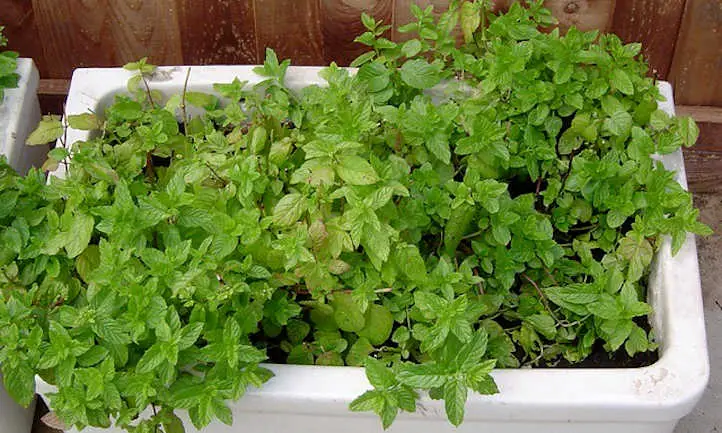
Mint is easy to grow, and it’s difficult to over or under-water it. However, if left in too moist soil, mint can experience damage to its roots. Mint can be damaged from too much dryness too. When the pot feels underweight due to a lack of moisture, it’s time to water your mint.
In a windowsill, you’ll find that direct sun evaporates moisture more quickly than other methods. Simply check your pot once or twice per week to ensure it’s not time to water. Then take the container to your sink, and flush water through. Leave it in the sink without a catchment tray underneath to drain off the excess water, and then return it to the windowsill.
Mint is one plant that enjoys high humidity. So in between watering, lightly mist the leaves with a spray bottle. You can also set the container on top of a tray of pebbles immersed in water that will provide ambient humidity as the water evaporates. This isn’t necessary if you’re watering enough.
Grow tents and hydroponics will provide adequate humidity and shouldn’t require extra watering. Try to keep the humidity content to at least 40%. You’ll be changing the water at the same frequency in a hydroponic system: once every 5-7 days.
Growing Medium & Container
For indoor mint growing, plant mint in a good quality potting soil in a pot that is large enough to accommodate the prolific growth of a mint plant. At least 8 inches in diameter and a depth of at least 12” will host a happy indoor mint plant. Make sure your pot has sizable drainage holes. Self-watering pots work ok for mint, especially if you’re finding the soil dries out quickly between waterings.
There are also solutions for those who want to grow in soilless media instead of soil. Growing mint in an evenly proportioned mixture of vermiculite, perlite, and peat moss works just fine. For those who would like to avoid peat moss, coconut coir works well too. You can try this in a container or in start in a coir starter pellet and then transfer it to a pot.
In hydroponics, you can grow in lightweight expanded clay aggregate which moves moisture into pockets that can be absorbed by your mint plant. The great thing about LECA is it’s reasonably priced when compared to coconut coir or even some potting soils.
The takeaway from all of this is you need good drainage for mint. It doesn’t mind moist soil, but it appreciates the slightly dry soil between waterings with ample humidity. You don’t have to fuss too much, though, because even indoors mint will do just fine with a regular schedule of water and light.
Fertilizing
You won’t necessarily need fertilizer for your indoor mint plant. However, mint does benefit from a liquid fertilizer applied every three weeks in warmer seasons, and every six weeks in winter. In hydroponic systems, use a high nitrogen liquid fertilizer and adjust the pH of your nutrient solution as needed after adding fertilizer. The same schedule goes for a container.
Pruning

All aromatic herbs — mint included — appreciate a good prune. Pruning foliage of all mint varieties promotes more growth, which leads to more mint leaves. And do we ever have enough mint? Never!
To prune, simply clip or snap off the top few leaves of your plant just before the next growth point, where the two leaves grow on either side of the mint stem. It’s best to prune cuttings that are at least a few inches long to avoid cutting stems that are too young.
When growing indoors, mint has the same requirements as it does outdoors when it comes to flowering. Remove flowers to prevent nutrient diversion toward flower production. Snap off the floral growth at the top of the plant just before the first growth point.
Outdoors sometimes it’s nice to have flowers for pollinators, but since you want bees outside instead of inside there’s no need here. Flowers also allow a mint plant to go to seed and reproduce.
Planting
Indoor mint growing can initially be done by seed or by cuttings — essentially harvesting mint. You can plant seeds in the soil of a pot or containers and wait for them to sprout. Try to keep just a few seeds per container, as mint will grow quickly and take over.
Each sprout will need about two feet between one another to thrive, so make sure you plant far enough apart. For most containers, this means just one plant can live there.
You can experiment with a few different types of mint here. Try growing spearmint and apple mint along with your Piperita. Try not to overcrowd each of the containers with too many seeds. Give your mint seeds light because they need it to germinate.
Start seed in rooter plugs for hydroponic systems. In both containers and hydroponics, seeds will take one to two weeks to germinate. You’ll want to keep the soil moist and set temperature controls for about 70 degrees Fahrenheit. Once you can see root poke out below the plug, and the seedling is at least a few inches tall, you can plant whatever species of mint you’ve chosen in your system.
It’s also very easy to propagate mint from an established plant. This is faster than growing from seed too. Harvest mint stems of an established plant above the woody parts, sticking to the fresh green part of the stem. Then immerse those cuttings in a cup with water and keep them out of the direct sun. Within a week or so, healthy white roots will grow into the water, and stems can be planted in soil or plugs for your hydroponics.
You can skip the water step and dip harvested cuttings into rooting hormone and place them directly in the soil. Within a week you’ll have a new mint plant.
Troubleshooting
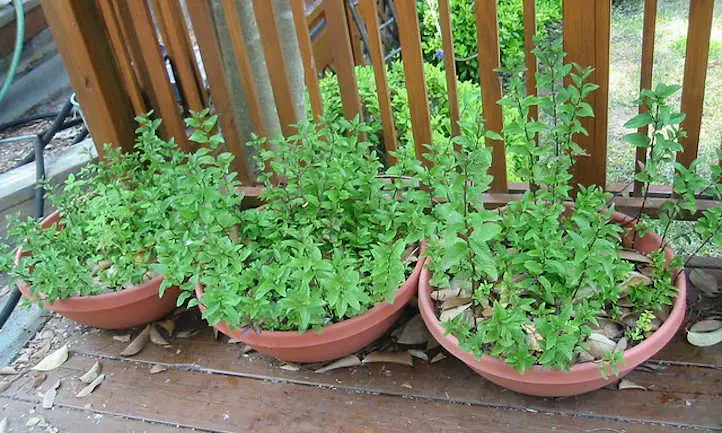
Thankfully, the menthol chemistry of most mint plants keeps a lot of pests at bay, which is why many choose gardening with mint. In indoor growing, it’s even easier to keep track of your plants and ensure everything is going according to plan.
Uneven moisture in the soil or growing medium, and uneven humidity are often the key issues people deal with when it comes to growing herbs indoors, like mint. Different species will have different specific requirements, but generally, mint likes high humidity and evenly moist soil.
If the soil remains too dry, add water. Too much dryness can cause browning on green leaves, damaging the flavor of your mint. In hydroponics, keep the nutrient solution fresh to give mint the care it needs.
Stems will brown as your mint matures, but if you notice premature browning, a mushy stem, and a lack of growth there may be an overwatering issue. This could also be related to fungal root rot, which can damage the overall mint plant and eventually kill it if not kept in check.
If you water overhead, you can create optimal conditions for mint rust fungus, which is a fungus that makes any species of mint its host. Water properly at the root level to prevent this.
Optimal conditions for fungus can lead to optimal conditions for fungus gnats, insect pests that can cause damage to mint’s roots in heavier infestations. To rid your plant of fungus gnats, set apple cider vinegar traps. Pour a little bit of ACV in a small cup, add some soap, and cover with plastic wrap. Poke a few holes in the plastic and you’re set. The gnats will go for the ACV, and the soap will keep them from exiting the trap. Dispose of the trap when all the gnats have been eliminated.
Too little light or too much indirect light will cause green leaves to brown as well as to etiolate, or stretch towards a light source. Plants in the mint family don’t like too much shade or indirect light. If your mint plant suffers from a lack of light, remove those leaves that have browned and adjust your lighting schedule. If you’re using a windowsill for mint gardening, you may need to purchase a grow light to eliminate excess shade.

